Table of contents
- Against blocking, for traction Electronic safety features on the motorcycle
- Anti-lock braking system
- Cornering ABS
- Traction control / anti-slip regulation
- Wheelie / stoppie control
- Electronically adjustable trolleys
- Motor mappings and driving modes
- Further electronic features
- Automated emergency calls
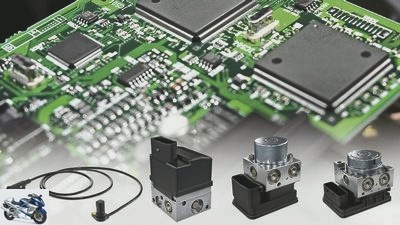
Photos: Yamaha
Sports & scene
Electronic security features
Against blocking, for traction
Electronic safety features on the motorcycle
Electronic assistance systems should make the performance of modern motorcycles manageable, offer comfort, but can also protect against falls. And there are more and more – a thorough look at the technical details is a good idea.
Nicolas Streblow
02.03.2017
At the moment, there is still a great deal of perplexity in the handling of most driver assistance systems, as at least an online survey by MOTORRAD suggests. The vast majority had no opinion on the vast majority of systems. Clear “on the other hand” The vote was only clearer for the automatic transmission “Therefore” but with ABS. That’s a good thing, because the anti-lock device is by far the most important direct assistance system and, since 2017, has even been a requirement for all new motorcycles over 125 cubic centimeters.
And the automatic? For most people it is a comfort feature that has no place in the motorcycle. In whatever form, it remains a matter of personal preference. On the other hand, a number of other electronic assistance systems, whose meaning and function has not yet got around, represent a gain for active safety such as ABS. A distinction must be made between systems that help, within physical limits, to prevent a slip and those that make driving more pleasant. This is primarily about comfort-oriented electronics. And then there are the little helpers who are even supposed to get help for us after an accident.
Assistance systems for driving dynamics can be useful in many situations. Regardless of whether they are called ABS, cornering ABS, anti-slip control, stoppie or wheelie control. What they all have in common is that we do not perceive them as long as we are on this side of the border area. In other words, to be on the road in such a way that it would be possible to do so without all the electronics, even with a conventional motorcycle without all the electronics. They only intervene when we cross the limit, i.e. when we would fall on our faces without them or at least have to do everything we can to avoid falling.
But what do the individual helpers actually do? And how do they do that?
“Motorcycling good and safe” can also be found as a booklet printed in MOTORCYCLE 6/2017
ORDER IN THE SHOP
Anti-lock braking system
Let’s start with the well-known ABS, which was first installed in series in 1988. If we apply the brake too hard, i.e. apply too much brake pressure, a valve opens and the brake pressure is reduced to such an extent that the wheel no longer locks.
In the event of a panic braking, the ABS unfolds the greatest wealth of benefits. Because it is precisely in this case, in which we almost inevitably fell earlier, that the technology now enables safe emergency braking. Modern systems work so hard at the optimum that even an experienced driver can no longer gain any advantage without them. Not even on the test track, not to mention everyday life.
Cornering ABS
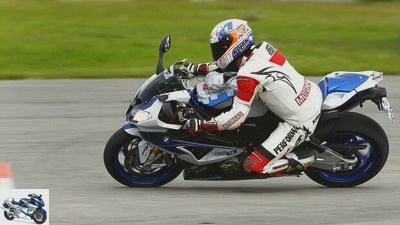
fact
Cornering ABS helps to keep the lane when braking in an inclined position and only to brake hard enough that the front wheel does not slip.
This applies in particular to the next level, cornering or lean angle ABS, first presented at the end of 2013 in the KTM 1190 Adventure.
Here, in addition to the slip of the wheels, the computer also includes the inclined position via so-called gyro sensors and, depending on the inclined position, reduces the brake pressure to such an extent that the cornering force is just sufficient. This is an enormous safety gain when braking in an inclined position!
However, if the grip is so bad that the wheel would have slipped without braking, cornering ABS will of course not help.
Traction control / anti-slip regulation
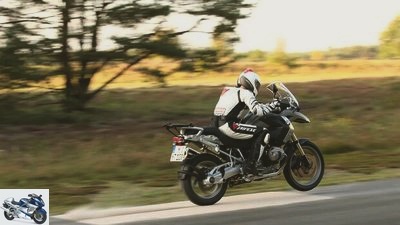
Jahn
The traction control reduces the propulsion when there is insufficient grip and thus prevents the rear wheel from breaking out of the way
The same applies to traction control or anti-slip regulation. It is virtually the opposite of ABS, it prevents the wheels from spinning when accelerating. Assuming that you are driving precisely straight ahead, that would not be a safety problem. However, if the road is not perfectly level or the motorcycle is tilted, there is a risk of a sideways slide. When the bike is crosswise to the direction of travel and the frightened driver closes the gas, the rear tire gets grip again and the machine throws its tamer in a high arc.
A traction control intervenes before it gets that far and, depending on the setting, regulates the power more or less gently. Because for professionals, the ASR, the anti-slip regulation, is often adjustable to enable targeted drifts. However, you should always be aware that we don’t have any on the front wheel “Slip control” to have. If we turn too hard and the machine pushes over the front wheel without braking, the anti-slip control will no longer help us.
Wheelie / stoppie control
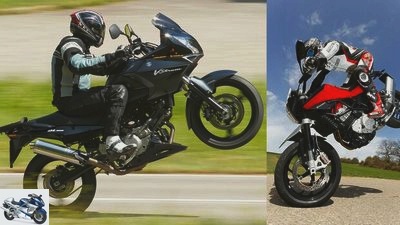
fact / Bilski
When braking and accelerating, sensors on both wheels monitor that both wheels are turning and that both are staying on the ground. If not, the power or brake pressure will be reduced
The wheelie control also works via the motor control. If the front wheel strives towards the sky when accelerating, the power is cut so far that it stays down. In the event of a stoppie, i.e. the rear wheel lifts off while braking, the front brake pressure is reduced to such an extent that the rear wheel just remains on the ground and the driving stability is maintained.
The latter device in particular is often referred to as rollover protection. Both techniques are currently used in motorsport in order to be able to brake and accelerate to the limit. During races, the spectator can clearly hear the onset of the ASR when accelerating out of the corners, by the changed engine noise. It goes without saying that powerful machines are also safer on the road, provided that the physical limits are not exceeded.
Electronically adjustable trolleys
Electronics has now also found its way into the chassis of modern bikes, in the form of spring elements that can be adjusted at the push of a button, which can be adapted to different load conditions or changing road conditions. Instead of getting your fingers dirty with a hook wrench, adjusting wheels or even screws, all you need to do is press a button, and the damping and spring preload are appropriately adjusted using electronically controlled servomotors.
Since an incorrectly adjusted chassis can also mean a safety risk in addition to limited driving pleasure, the bits and bytes instead of the clicks are more than an extra convenience. Especially when the driver is not deep enough into the subject to pick the right one from the countless possibilities.
The idea becomes completely fascinating when a “active “”Chassis Damping and response behavior of the spring elements automatically adjusts to the respective road surface even while driving and depending on the speed.
Motor mappings and driving modes
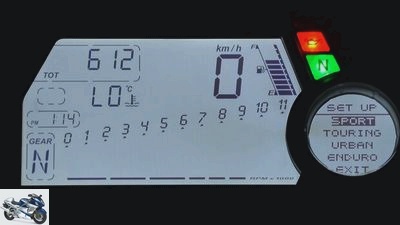
Ducati
Different configured combinations of throttle response, ABS, traction control and suspension settings can be selected here
Adjustable engine mappings, in which the reaction of the injection system to commands from the throttle grip can be adjusted, can also be of great help to driving safety. Crisp and direct for a brisk drive on dry roads, for example, or a little more restrained and more gentle on wet roads.
The culmination of many current travel enduros, super sports bikes and large tourers is the combined setting option of all the parameters mentioned so far by selecting different riding modes. In the position “Sports” For example, the response to the gas is more direct, full power is available, ABS and ASR control late, the damping is tight. at “Urban” the power is reduced, the engine accelerates more gently, the chassis does not act as tightly and ABS and ASR intervene earlier. at “Enduro” the damping is then opened even further so that the wheels always keep contact with the ground on bumpy terrain; ASR allows drifts, and ABS reacts late at the front, and depending on the model, is even switched off at the rear.
The complete networking of all parameters can be achieved, for example with a setting for “rain”, make handling a powerful, heavy motorcycle easier. The engine then accelerates particularly gently and the anti-slip control intervenes so early that nothing can happen even when accelerating in an inclined position.
Further electronic features

Artist
The cornering light is controlled by inclined position sensors and compensates for the reduced light output of the inclined headlights
No driving aids, but cornering lights and are very useful for active safety “Blind Spot Assistant”.
In the case of cornering lights, an inclined position sensor, coupled to swiveling reflectors, ensures good illumination of the road, even when cornering, where you usually like to push a large, black wedge in front of you.
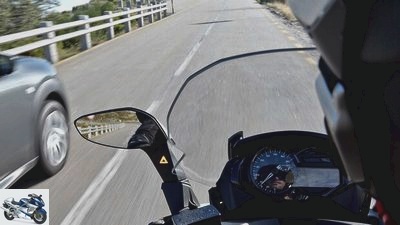
BMW
the “Blind Spot Assistant” flashes with a triangle when there are vehicles in the mirror’s blind spot.
the “Blind Spot Assistant” warns with a luminous triangle of vehicles in the next lane that we would only see if we turned our head on the side. In two-wheelers currently only installed by BMW on the large C 650 GT touring scooter, this technology has already found its way into many models in the automotive sector. Hopefully it will always reliably detect motorcycles and scooters in the blind spot.
Automated emergency calls
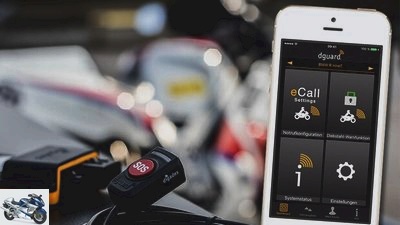
Photos: digades
E-Call, the automatic emergency call system, mandatory for new cars from 2018, is available for motorcycles from two manufacturers. On the left the dguard retrofit solution from digades, on the right the version from BMW Motorrad that can be ordered ex works
If, despite all caution, an accident does occur, a system such as E-Call can help. Permanently installed on the motorcycle and connected to a control center via a mobile phone emergency call, E-Call calls for help if the sensors detect an accident or fall, even if the driver is no longer able to do so. If he is responsive and has a headset built into the helmet, the control center can also make contact.
This function can save lives, especially in single accidents on lonely routes. But even if the biker has an accident, he can take action himself and use the SOS button to reach the emergency call center directly and get help.
In the automotive sector, the networking of road users is already being decisively promoted. Vehicles can communicate with each other via WLAN and cellular radio, for example, and recognize approaching other vehicles before the driver can see them himself. You can either only warn the driver or the technology can even initiate driving maneuvers to avert an impending collision.
Many manufacturers are already working on systems that also include motorcycles. One can only hope that in this way fewer motorcyclists will actually be overlooked in the future.
Related articles
-
Electronic driver assistance systems for motorcycles
Yamaha 35 pictures www.factstudio.de 1/35 How things are going? It was a long way from the almost purely mechanical cockpit of the Yamaha SR 500 to the…
-
Electronic landing gear under the microscope
www.bilski-fotografie.de 15th pictures Jacek Bilski 1/15 Chassis are the link between the road and the motorcycle. So far, they have usually been set…
-
fact 7th pictures fact 1/7 BMW HP4, the new S 1000 RR, Ducati Multistrada or Aprilia Caponord: they are all equipped with active damping components. ZF…
-
Technology PS driving dynamics cornering ABS
markus-jahn.com 18th pictures markus-jahn.com 1/18 … as well as in the city to its limits. markus-jahn.com 2/18 On the one hand, this smooth transition…
-
Cornering ABS and traction control regulate more often than expected
Photo: markus-jahn.com 6th pictures Bosch 1/6 The so-called curve ABS at a slope of 35 degrees on dry asphalt. The driver brakes in an inclined position,…
-
Driver assistance systems for motorcycles
Hirano Ami counselor Driving experience & Driving tips Driver assistance systems for motorcycles Assistance systems For comfort and security Motorcycles…
-
Driving report: Mercedes F 300 Life-Jet
motorcycles Driving report: Mercedes F 300 Life-Jet Driving report: Mercedes F 300 Life-Jet Wankomat Mercedes on a new path: The long-established company…
-
KTM 37 pictures Jahn 1/37 KTM 2/37 KTM 3/37 KTM 4/37 KTM 5/37 KTM 6/37 KTM 7/37 KTM 8/37 KTM 9/37 KTM 10/37 KTM 11/37 KTM 12/37 KTM 13/37 KTM 14/37 KTM…
-
4 lean ABS systems in the endurance test
4 lean ABS systems in the endurance test Lean ABS systems put to the test 4 current curve anti-lock braking systems in comparison Full in the irons with…
-
Held In & Motion airbag vest – security to clip in and by subscription
Tobias Burger 10 pictures hero 1/10 Clothing specialist Held has worked with In&Motion added a new supplier of airbag vests to its portfolio. hero 2/10…